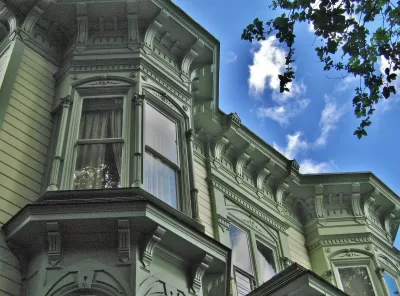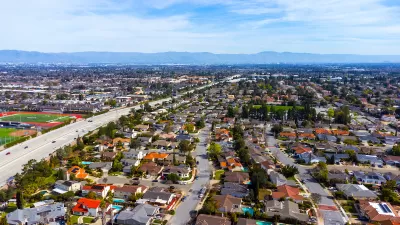A longtime resident of an old, eclectic neighborhood reflects on what makes the area so desirable and why new places like it are effectively outlawed today.

For decades, Robert Liberty has called Northwest Portland home. Blessed by an eclectic mix of housing types and uses, his neighborhood plays host to diverse residents, young and old, and a collection of small businesses including restaurants, grocers, dry cleaners, small warehouses, and a sheet metal company.
Liberty laments that despite the obvious character his neighborhood exhibits - and the high premiums residents pay to live there - the area is "illegal" in most modern zoning schemes. He writes, "residential zoning today has carried class separation to great extremes, which you can see if you travel by air: Over here, big single-family homes on big lots. Over there a mobile home park."
The desire to preserve parking, to segregate immigrants and the poor, and to guard land value and "neighborhood character" has led, ironically, to a shortage of adaptable urban environments. Liberty concludes, "Does that mean do away with all regulations? No. But it does mean that we need to stop assuming that everyone wants to, or can afford to, live in a big-house on a big lot in a residential-only neighborhood."
FULL STORY: My illegal neighborhood

Study: Maui’s Plan to Convert Vacation Rentals to Long-Term Housing Could Cause Nearly $1 Billion Economic Loss
The plan would reduce visitor accommodation by 25% resulting in 1,900 jobs lost.

Alabama: Trump Terminates Settlements for Black Communities Harmed By Raw Sewage
Trump deemed the landmark civil rights agreement “illegal DEI and environmental justice policy.”

Why Should We Subsidize Public Transportation?
Many public transit agencies face financial stress due to rising costs, declining fare revenue, and declining subsidies. Transit advocates must provide a strong business case for increasing public transit funding.

Paris Bike Boom Leads to Steep Drop in Air Pollution
The French city’s air quality has improved dramatically in the past 20 years, coinciding with a growth in cycling.

Why Housing Costs More to Build in California Than in Texas
Hard costs like labor and materials combined with ‘soft’ costs such as permitting make building in the San Francisco Bay Area almost three times as costly as in Texas cities.

San Diego County Sees a Rise in Urban Coyotes
San Diego County experiences a rise in urban coyotes, as sightings become prevalent throughout its urban neighbourhoods and surrounding areas.
Urban Design for Planners 1: Software Tools
This six-course series explores essential urban design concepts using open source software and equips planners with the tools they need to participate fully in the urban design process.
Planning for Universal Design
Learn the tools for implementing Universal Design in planning regulations.
Smith Gee Studio
Alamo Area Metropolitan Planning Organization
City of Santa Clarita
Institute for Housing and Urban Development Studies (IHS)
City of Grandview
Harvard GSD Executive Education
Toledo-Lucas County Plan Commissions
Salt Lake City
NYU Wagner Graduate School of Public Service





























